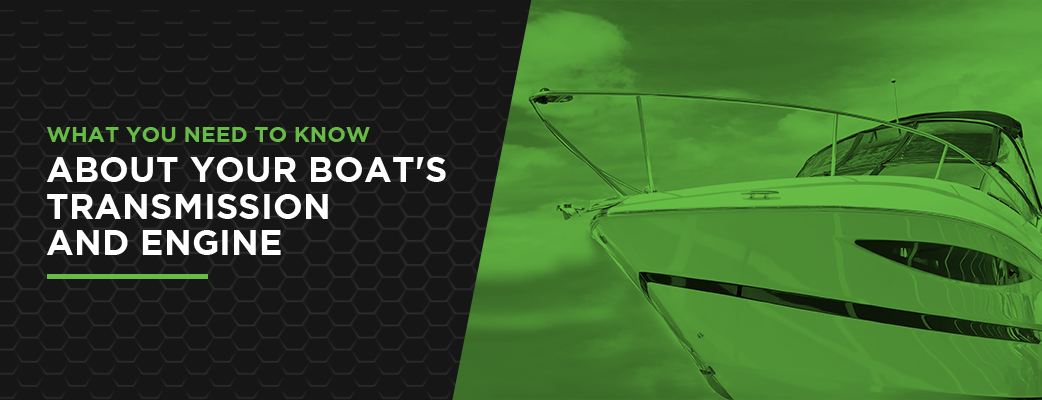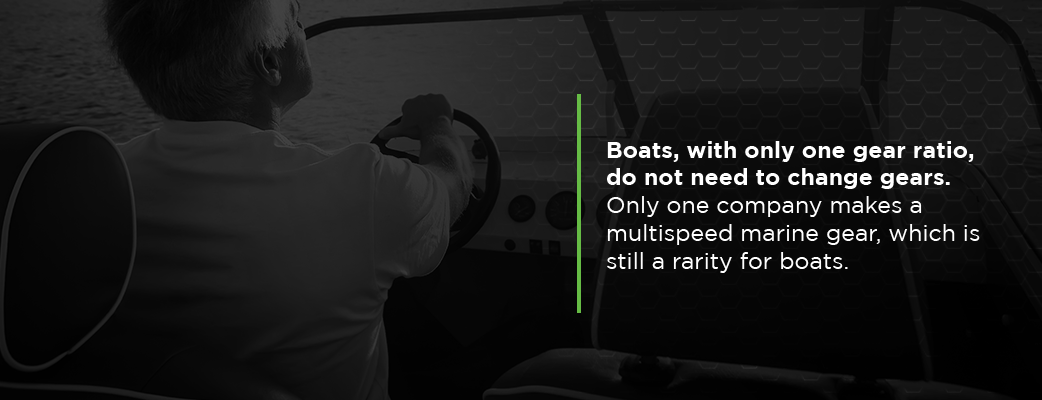
Owning a yacht or large workboat comes with the responsibility of maintaining the marine diesel engine and transmission that drive it. The more you know about how your boat works, the easier keeping up with regular service chores on it will be. Discover everything you have ever wanted to know about your boat’s transmission and engine here.

Why Learning More About Your Boat’s Transmission and Engine Matters
Knowing about your boat’s operation and the components that make it run will help you in three primary ways — shopping for a pre-owned or used boat, troubleshooting problems and making repairs.
1. Shopping for a Used or Pre-Owned Boat
While many may look at the exterior of a boat when comparing models, real aficionados know to look at the inner workings of the ship. The engine and transmission serve as the backbone of the boat’s operation. Without quality in these components, even the most beautiful boat will not leave the marina.
You need to know how the engine and transmission work together to get your boat to move. Only then will you understand the specs you need to get the most from your boat. A workboat will need an engine and transmission capable of working harder than a yacht would.
2. Troubleshooting Problems
Unless you know what you’re looking at when you examine the engine, troubleshooting problems will be difficult to impossible. Several operation problems start in the engine or transmission, but some people don’t know what to look for due to a lack of knowing how these components work. Since they cannot properly assess the situation, they do not fix the problem, resulting in the continued use of a failing boat. The small problem will likely get worse until you need to call for an emergency tow back to the marina.
3. Making Repairs
To save money and ensure your engine lasts its longest, you may want to make repairs yourself. In some instances, you may find yourself without a choice if you must repair a damaged part while on the water. The more you know about your engine’s operation, the faster you can diagnose an issue and make the necessary repairs the first time.
If you have a good understanding of your transmission and engine, you can also know about which replacement parts you need to buy. Ordering becomes straightforward, instead of a chore. You can also make better decisions when ordering repair components. Being able to compare the quality of different parts makes it easier to appreciate how they fit into your boat’s operation.
What the Engine and Marine Transmission Do
The engine and marine gear drive your boat forward or backward by powering and controlling the propeller. These components are vital to how you operate your boat. You need to understand how these parts work to identify problems and make repairs.
1. What an Engine Does

The engine provides power for the propeller to move the boat. You have options for inboard and outboard motors. Boats with inboard engines completely house the entire motor inside the boat. Outboard motors sit on the outside edge to drive smaller boats. When it comes to yachts and large workboats, the difference between inboard and outboard boats is not an issue, since these larger vessels usually have built-in engines.
Marine diesel engines, regardless of their orientation on the boat, have two main mechanisms — two-stroke and four-stroke. These refer to how many strokes of the pistons the engine needs to get power from the fuel.
Four-stroke engines frequently appear on smaller boats. These start with a downward stroke called the suction stroke that pulls fresh air into the chamber. Next, the piston moves up in the compression stroke to compress the fuel and air until the diesel ignites. The explosion caused by the igniting fuel causes the piston to move down in the power stroke. Lastly, the piston moves back up in the exhaust stroke to expel exhaust gases.
Two-stroke engines provide more power and typically operate larger boats. The intake and compression both occur with a single upward stroke. The explosion causes both the power and exhaust to occur on the same downward stroke.
With the movement of the pistons, the crankshaft turns. A flywheel attached to the crankshaft may connect to an alternator to charge a battery or to a propeller system for mechanical work.
Other components include a fuel pump to get diesel into the cylinders and a cooling system to keep the engine from overheating.
2. What a Marine Transmission Does

First, instead of referring to it as a transmission, call it a marine gear. While it does have gears, most have only one set instead of multiple. Marine gears have three main functions, which are:
Set ratio between propeller rpm and engine rpm
Engage or disengage the propeller as needed for neutral operation
Reverse the propeller’s direction
The marine gear can also operate an auxiliary device connected to it. If you want, you can install a hydraulic pump that the transmission runs.
Manual vs. Automatic Transmission

Boats, with only one gear ratio, do not need to change gears. Only one company makes a multispeed marine gear, which is still a rarity for boats. The design of the propeller provides enough slip. Because the propeller does not have resistance against the water when it turns, it gives the marine gear the slip it needs.
Understanding Boat Engine Terminology
You will come across several terms for the components of your boat’s engine. To know what owner’s manuals mean when they refer to these parts, you must understand the terminology. Knowing these terms will make troubleshooting and part replacement easier.
1. Air Filters
Air filters remove particulate matter from the air before entering the engine for combustion. These need regular replacement to keep them clean and working at their best.
2. Cooling System
The water your boat travels in, either freshwater or seawater, cools the coolant that circulates through the engine and draws off heat. This type of closed system keeps the raw water from corroding your engine, as it did in significantly older boats that used open cooling systems.
While your engine stays protected from the corrosive effects of the freshwater or seawater, you must annually service the raw water heat exchanger portion of your boat’s engine.
3. Engine Mounts
The engine mounts, made of neoprene, provide cushioning for the engine’s supports and absorb vibrations caused by the motor’s operation. The rubbery consistency helps prevent the engine from damaging or sending vibrations to the boat’s body. When the mounts age and harden, they no longer act as vibration absorbers.
4. Fuel System
The fuel system consists of the pump and injectors that deliver fuel from the tank to the cylinders. Problems with this system can prevent the engine from running.
You should have two fuel filters to keep water and dirt out of the engine. The primary filter catches the largest particles, while the secondary filter has a finer mesh for smaller debris.
5. Turbochargers
Turbocharged diesel engines compress air before it moves into the cylinders. They increase the power generated by the engine. The turbocharger has a compressor that increases the air pressure of fresh air entering the engine and a turbine that moves the exhaust gases out faster.
Boat Transmission and Engine Maintenance — What You Need to Know
When it comes to maintaining your boat, you must know about the proper service intervals and what to do for your engine and transmission. Because every manufacturer builds its motors and marine gears with different specs, always consult the user’s manual and the transmission manual to find out how often a boat should be serviced.
1. Engine Maintenance

For engine maintenance, you need to regularly maintain your boat, at least when winterizing it and taking it out at the beginning of the season.
Replace air filters that have become clogged or appear dirty. Check these at least once a season, or more often if you use your boat near a heavily polluted city.
Check your boat’s owner’s manual for engine oil change intervals. Diesel engines need more frequent oil changes than gasoline engines. Have a mechanic examine your boat’s engine if you notice black sludge under the oil filler cap or if you see water. Creamy-colored oil during operation also indicates a severe problem a mechanic needs to repair.
Each year, flush out the raw water portion of your cooling system and replace the pump impeller. These components, exposed to the corrosive effects of seawater or the coating effects of freshwater contaminants, need regular service to prevent a breakdown of the heat exchanger. Also, every three to four years, test the pressure cap for maintaining the pressure embossed on its surface. Alternatively, replace the cap at these intervals as preventative care.
Check all hoses and belts for integrity. Replace any worn or cracked parts to prevent a breakdown while on the water. Also, check for cracking of the engine mounts. Though made of neoprene, these can wear out with age, leading to engine vibrations.
At least twice a season, replace the fuel filters and check the fuel lines. Usually, fuel lines have a flexible feel. If they start to get stiff, you need to replace them before they crack, which increases the risk of leaking fuel and fires.
Check the turbocharger for any excessive movement, which indicates it needs replacement. If you use a turbo blanket to protect your boat’s engine from the turbocharger’s heat, replace it if it becomes oily, dirty or cracked. These situations create a fire hazard.
2. Marine Gear Maintenance
To properly maintain your marine gear, refer to the owner’s manual or check the manufacturer’s website. You will find vital information such as the correct interval for changing transmission cooling oil and recommended brands for oil and filters.
Because most yacht and other pleasure boat owners rarely meet the necessary use for oil change intervals, plan to change the transmission oil at least once a year. Doing so will prevent severe problems in your marine gear from dirty oil.
Dirty oil causes severe problems for your boat transmission. You could experience clogged filters and particulate matter getting into the clutch. The clutch plate may slip and disengage. Regular transmission oil changes can prevent these issues.
If you do not remember when you last changed your transmission cooling oil, check the temperature. Generally, the oil temperature should range between 120 and 140 degrees Fahrenheit. If it regularly starts running hotter, something is wrong with your cooling system. You may need to replace the oil, or you could have seawater corroding the interior of the system.
You likely won’t have to worry about replacing the clutch plate in your marine gear because this part can withstand several tens of thousands of hours of use, more than you will put on it.
Parts you do have to focus on for inboard transmission maintenance include the cooling system and zincs. Use your engine’s maintenance interval for servicing these parts. Whenever you replace the zincs in the engine, do the same in the transmission’s cooling system. Similarly, clean out and test your transmission’s cooling components when you do the same for your boat’s engine.
Find the Diesel Engine and Transmission Parts Your Boat Needs
Shop For Twin Disc Marine Transmission Parts & Rebuilt Transmissions
Shop For Allison Marine Transmission Parts & Rebuilt Transmissions
Knowing more about your boat will make it easier to find and install replacement parts when you need them. For all the engine and transmission parts you need for your boat, shop our selection at Diesel Pro Power. You will find what you need here and can get 24-hour worldwide shipping. Ask any of our 15,000 satisfied customers and growing, and you will see we are the one-stop shop for all your marine diesel engine and transmission needs. If you have any questions about our parts or selection, contact us, and we’ll get an answer back to you as quickly as possible. Our goal at Diesel Pro Power is to give you the best place to get the parts you need for your boat.



 Free US Calls: 1-888-433-4735
Free US Calls: 1-888-433-4735 International: 305-545-5588
International: 305-545-5588
